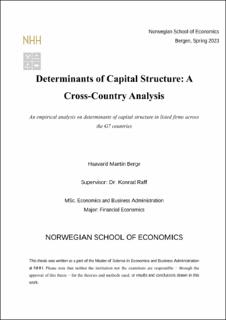Determinants of Capital Structure: A Cross-Country Analysis : An empirical analysis on determinants of capital structure in listed firms across the G7 countries
Master thesis
Permanent lenke
https://hdl.handle.net/11250/3088289Utgivelsesdato
2023Metadata
Vis full innførselSamlinger
- Master Thesis [4372]
Sammendrag
This study aims to investigate how firms operating in different institutional, regulatory, economic and cultural settings determine their capital structure in the period 2012 to 2019. As previous research commonly limits their analysis to a singular country or industry, this thesis emphasises why and how determinants of capital structure may differ between countries. I analysed firms' capital structure across the G7 countries through the lens of the trade-off theory, the information asymmetry theory, and the market timing theory.
Using Debt-to-Capital as the dependent variable measured individually by book values and market values, I identify seven firm-specific factors that reliably determine capital structure across the G7 countries using the fixed effects estimation model and robust standard-errors: tangibility (+), market-to-book ratio (-), size (+), profitability (-), liquidity (-), Altman’s Z-score or probability of bankruptcy (-), and industry median leverage (+). Furthermore, while demonstrating varying levels of significance across the sample countries, five additional factors were observed as reasonable determinants of capital structure: non-debt tax shields (+), term spread (+/-), corporate taxation rate (-), revenue volatility (+/-), and lagged leverage (+). The effectualness of these variables is observed to deviate between countries, thereby suggesting a firm’s capital structure is heavily influenced by its environment. I argue the cross-country differences in determinants of capital structure originate due to differing economic and institutional development and stability, tax codes and insolvency laws, corporate culture, and exposure to capital markets.
